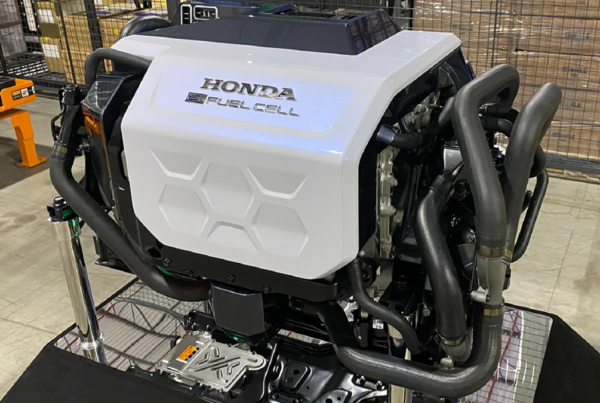
A collaboration between researchers from the University of Cambridge and Imperial College London demonstrated that artificial leaves made of readily available oxide and carbon-based materials can produce hydrogen from water over several weeks. The leaves, which consist of a few light harvesting spots (that is, pixels) showed a higher performance over conventional devices with a single larger pixel.
The researchers achieved this benchmark by sandwiching an Earth-abundant BiOI light absorber between two oxide layers. “These oxide layers improve the ability to produce hydrogen compared to stand-alone BiOI”, said Robert Jagt (Department of Materials Science and Metallurgy, University of Cambridge), one of the co-lead authors.
“We have been working on this material for some time, due to its wide-ranging potential applications, as well as its simplicity of fabrication, low toxicity and good stability. It was great to combine the expertise of the different research groups across Cambridge and with Imperial to demonstrate yet another potential application – clean hydrogen production”, said Prof. Driscoll (Department of Materials Science and Metallurgy, University of Cambridge).
The robust oxide-based device structure was further coated with a water-repellent graphite paste, which prevented moisture infiltration. In this way, the stability of the BiOI light absorber could be prolonged from minutes to a couple of months, including the time the devices were left in storage. The devices could produce hydrogen for 500 h when dipped in solution, which is comparable with stability tests reported for some of the latest developed solar cells under air. These findings were published in the journal Nature Materials.
Despite the high performance of solar cells, the efficient storage of electricity still poses challenges. Solar fuels provide a promising alternative, by storing energy in the form of chemical bonds, which take less space over batteries. One of those energy carriers is hydrogen, which is expected to play an important role in transitioning towards a renewable economy.
While many light absorbing materials have been tested for solar fuel production, most degrade quickly when submerged in water. That was also the case for bismuth oxyiodide, a semiconductor which has been overlooked for solar fuel applications due to its poor stability in water.
“BiOI is a fascinating photoactive material that has energy levels at the right positions for water splitting. A few years ago, we demonstrated that BiOI solar cells are more stable than those using state-of-the-art perovskite light absorbers. We wanted to see if we can translate that stability to artificial leaves”, said Robert Hoye, a lecturer in the Department of Materials, Imperial College London, and one of the corresponding authors.
While perovskites are the fastest-growing materials in terms of light harvesting efficiency, they contain lead. This presents a risk of leakage, therefore researchers have been working on developing lead-free alternatives.
A further improvement in the device performance was obtained when assembling the device from many small pixels, instead of a larger one. “Even if some pixels are faulty, we can disconnect them so they don’t affect the rest. This means we can sustain the performance of the small pixels on a larger area”, said Virgil Andrei (Department of Chemistry, Cambridge), a co-lead author on the study.
This increased performance enabled the devices to not only produce hydrogen, but also reduce CO2 to syngas, an important intermediate in the industrial synthesis of chemicals and pharmaceuticals.
“This is an exciting development! At the moment, few solar fuel systems show stabilities which are compatible to real-world applications. With this work, we make a step forward towards establishing a circular fuel economy”, said Erwin Reisner (Department of Chemistry, Cambridge), one of the corresponding authors.
This work was in part supported by the Cambridge Trust, the Winton Programme for the Physics of Sustainability, the Royal Academy of Engineering, the Engineering and Physical Sciences Research Council (EPSRC), and the European Research Council. Judith Driscoll is a Royal Academy of Engineering Chair in Emerging Technologies. Robert Hoye is a Royal Academy of Engineering Research Fellow. Virgil Andrei and Erwin Reisner are Fellows of St John’s College, Cambridge.
Read the most up to date Fuel Cell and Hydrogen Industry news at FuelCellsWorks




